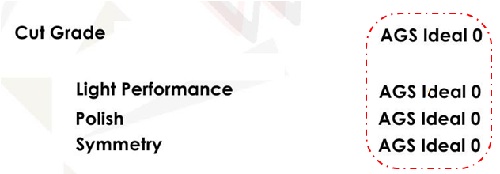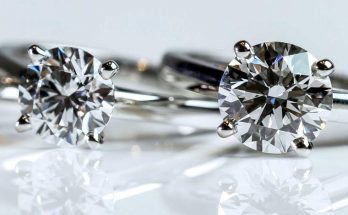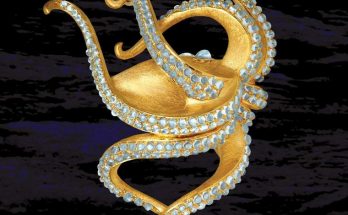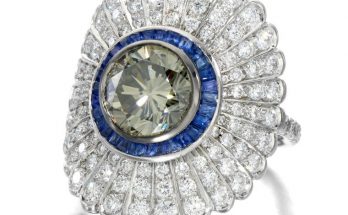In the industry, AGS (American Gem Society) and GIA (Gemological Institute of America) are considered to be 2 of the most reliable gemological labs in the world. Interestingly, they were both founded by the same man who goes by the name of Robert Shipley.
GIA is most famously known for pioneering the grading process for diamonds. Their system standardized the nomenclature used in the diamond industry and is emulated by almost every other gemological lab in the world. GIA also has the greatest reach with laboratories based in every major location of diamond cutting and trading – Belgium, New York, Hong Kong, India and etc…
Being relatively new in the game, AGS is better received in the US than other parts of the world. Outside the United States, AGS certificates are often used by jewelry companies to help market and brand their products. For example, you will find AGS reports for international brands like Hearts on Fire.
In my professional point of view, these are the only 2 labs that provide precise and consistent grading services. Personally, I would only consider buying a diamond IF it had been graded by either lab. And, I am not alone in my thinking. In a recent expert round up I did, professionals I interviewed also stated that the source of grading report is an important attribute which affects their own purchases.
From a consumer’s standpoint, you might be more interested to find out what are the differences between AGS and GIA in terms of cut grading. I will talk about this in a moment.
American Gem Society – Paving the Way for Ideal Cuts
AGS prides itself as being the pioneer of the ideal cut grading for round diamonds. They were also the first in the world to apply a scientific vetted methodology for analyzing cut quality. AGS uses a numerical scale of 0 to 10 to describe a diamond’s cut quality; with lower numbers being of higher quality.
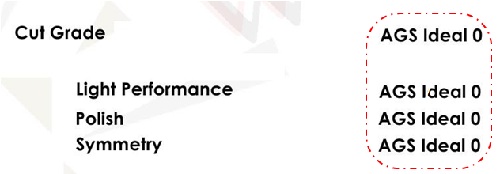
The highly sought-after triple zero (ooo) ideal cut ratings.
Here’s a little history about cut grades and their evolution. Back in the 1990’s, the only way for a diamond to attain an “ideal cut” grade was to send the diamond to AGS and meet the proportions guidelines set by them. At that time, the rise in AGS’s popularity stemmed from being able to offer a detailed cut rating which the other labs couldn’t do so. However, with the introduction of GIA’s 5-grade cut rating system in 2006, AGS eventually saw a drastic reduction in their market share over the years.
GIA – Gemological Institute of America
GIA is currently the most popular grading lab in the industry. Top tier GIA diamonds receive a “triple excellent grade” – meaning that the stone has achieved an excellent rating for all 3 aspects of polish, symmetry and cut. In the AGS system, the equivalent rating is known as “triple ideal (000)“.
Ironically, when GIA introduced their new cut grading system in 2006, it was highly criticized for being “lenient”. There was a very wide range of proportions which allowed a diamond to be rated as triple excellent. This enabled cutters to “work the system” and easily obtain an excellent cut rating for a diamond which barely passed standards.
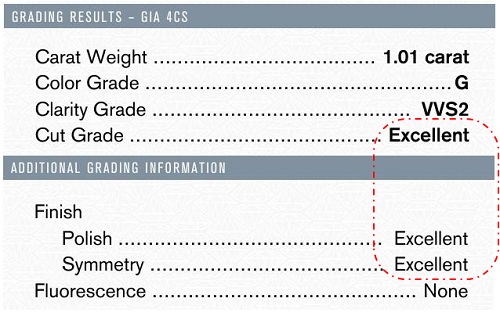
AGS vs GIA – What’s the Difference in Their Approach to Cut?
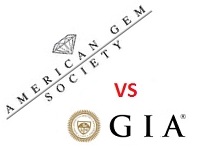
Who is Better? AGS or GIA?
Both GIA and AGS apply proportion-based grading techniques when judging the overall cut quality of a diamond. Besides utilizing computer algorithms, GIA also applies an observational aspect by having trained gemologists physically inspect a diamond for brightness, fire and patterning. This system is pretty much on par with the AGS Gold report.
On the other hand, AGS offers a higher level of performance based grading report in their “Platinum Diamond Quality Document”. In order to determine light performance, they run a 3-D analysis of the diamond with their proprietary ray tracing software.
To a certain degree, AGS utilizes a more technologically advanced grading method where every single facet is considered in the assessment. Whether big or small, every cutting mistake or design flaw on the diamond will show up as areas of lesser brightness, inconsistent contrast patterning or light leakage.
A Lab Report is Useful But It Doesn’t Reveal Everything
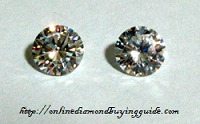
Fire And Scintillation
In my opinion, both laboratories are equally as good as each other in terms of grading standards. For the general consumer, these are the only 2 labs that you should consider when purchasing a diamond. However, you shouldn’t get too carried away by the different nomenclature used by these 2 labs.
There could be times where an AGS ideal cut might not perform as well as a GIA excellent cut diamond. Vice versa, a GIA excellent cut diamond might sometimes not perform as well as an AGS ideal cut. More importantly, 2 diamonds graded with AGS ideal doesn’t mean that both are equally good.
The point I am trying to get through here is that no lab is perfect. While the AGS report has a slight edge of grading diamonds for light performance, it isn’t an end all be all.
Confused? Let me give you an analogy to help you understand this. For example, 2 students both attain an A in their examination. However, one student’s A could be based on a score of 79/100 while the other student’s A grade was due to a score of 96/100. Just because both students got A’s in their exams doesn’t mean that they are equally smart.
And that is the truth behind the cut grades you see on a piece of paper. Besides the cut grades listed in a lab report, the use of supplementary tools like an Idealscope or ASET scope would offer a more objective way of determining a diamond’s optics.
How Jewelers Try to Portray Their Diamonds Differently
Here’s an interesting perspective about the labs. In many local stores and even large jewelry chains, you might have observed huge amounts of marketing being performed on diamonds with fanciful names – CanadaMark, HeartStar, Destinee and the list goes on.
Usually, these are nothing more than the common 57 facets round diamond that had received an ideal cut rating by AGS. And needless to say, these stores are going to charge you an arm and leg by making you believe these “premium cuts” are unavailable anywhere else or are exclusively carried by the company.
Here’s another phenomenon I observed in the diamond business. Due to AGS’s cut grading system which uses nomenclature like Ideal – Excellent – Very Good and etc, many companies use the term “ideal” as a marketing strategy to place such diamonds on a pedestal.
Since GIA’s cut grading system only ranges from Excellent – Very Good – Good and so on, it may seem like GIA diamonds are a notch lower in terms of cut quality. As a result of the different terminologies, many consumers are often misled into thinking that a GIA excellent cut is always inferior to AGS’s ideal cut.
There Are So Many Brands Out There. Which is Best?
In the retail business, a brand name can help customers to identify a product. This leads us to the next topic of how jewelers take advantage of branding and a combination of advertising strategies to market their product. You might have even heard jewelers touting their signature cuts to be the best and better than their “competitors”. However, is that really true?
More often than not, it is pure marketing fluff. Don’t take the jeweler’s word on quality until he/she backs it up with tangible data. Using an analysis of a trusted brand as an example, I will show you how to apply the same methodology to see if a particular diamond lives up to its quality and price justification. Click the next page to continue reading…
<<
>>
SOURCE:http://beyond4cs.com/shapes/round/gia-vs-ags-cut-grading/
